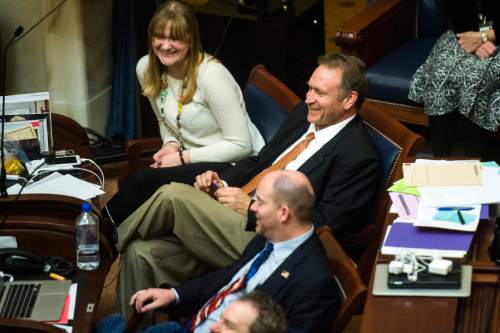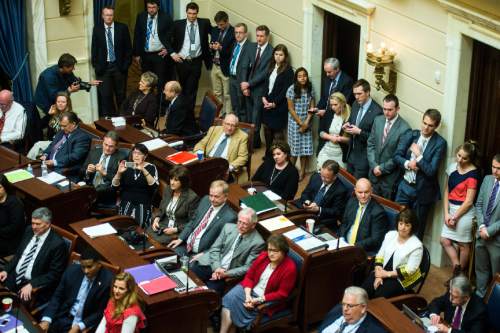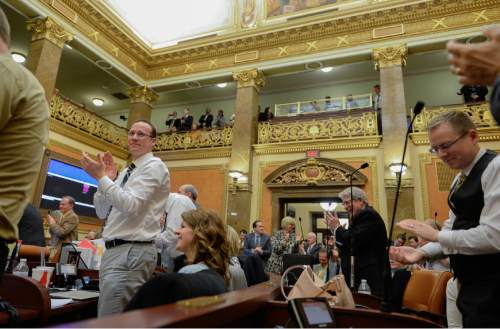This is an archived article that was published on sltrib.com in 2016, and information in the article may be outdated. It is provided only for personal research purposes and may not be reprinted.
Adam Brown, a Brigham Young University political science professor, noticed some things that may be unexpected about the Utah Legislature this year:
• Most votes were nearly unanimous.
• Republicans and Democrats passed about the same percentage of their bills, even though Republicans hold 84 percent of the seats.
• A handful of legislators passed truly high numbers of bills, while a different set introduced many but suffered through miserable success rates.
Brown has become known for slicing and dicing data of all sorts about the Legislature in recent years and posting the findings on his blog site, often seeing them used later in campaigns for or against lawmakers.
"I spend a lot of time up there watching, usually to observe and mentor my students who are there interning," Brown said. "As I observed, I noticed patterns from the galleries," and he decided to gather data about them.
Here are some of his more interesting findings from this year.
—
Unanimity • The average floor vote passed with 93 percent support in the House and 96 percent in the Senate. Brown said passage rates have been that high for at least the past decade.
"It's actually rare to see a vote where most Democrats vote against most Republicans," he said. That happened in only 14 percent of House votes this year and 6 percent of Senate tallies.
This year, a bill sponsor's party affiliation didn't seem to make much difference. Republicans passed 59 percent of their bills, and Democrats passed 53 percent. Brown said that "is the narrowest party gap we've seen in a long time."
He said many are surprised by so much unanimity in the Legislature. "People get so used to hearing about Congress that they don't realize how different a state is."
Brown said, "Congress works on big, major issues that lead to partisan divides and we think that's how politics works. But you look at the Legislature, and they are doing ground-level governance."
He added, "Many of the bills are simple. For many of the ones that aren't, the legislative process makes them palatable by the end. They amend them and they substitute them so by the time they come to a final vote, people on the whole feel good about it — even if the sponsor doesn't recognize it anymore."
—
Heroes, zeros • Brown's data show who passed the most measures, and who likely was the most frustrated.
Those who cleared the most were: Sen. Todd Weiler, R-Woods Cross, 19 bills; Sen. Wayne Harper, R-Taylorsville, 15; Sen. Karen Mayne, D-West Valley City, 14; Sen. Howard Stephenson, R-Draper, 13; and 12 each for Sens. Kevin Van Tassell, R-Vernal, Majority Leader Ralph Okerlund, R-Monroe, and Rep. Steve Handy, R-Layton.
"It's usually Senate Republicans who dominate that number," Brown notes.
Ten senators passed all the bills they introduced, but some filed only one.
Passing 11 of 11 was Sen. Ann Millner, R-Ogden. Going six for six were House Majority Leader Jim Dunnigan, R-Taylorsville, and Sen. Brian Shiozawa, R-Cottonwood Heights. And three for three were Sen. Pete Knudson, R-Brigham City, and Reps. Stewart Barlow, R-Fruit Heights; Marie Poulson, D-Cottonwood Heights; and Curt Webb, R-Logan.
Going one for one were House Speaker Greg Hughes, R-Draper; Senate President Wayne Niederhauser, R-Sandy; and Rep. Keith Grover, R-Provo.
Six legislators passed no bills, including Reps. Kim Coleman, R-West Jordan; Dixon Pitcher, R-Ogden; Brad King, D-Price; and Marc Roberts, R-Santaquin; and Sens. Allen Christensen, R-North Ogden, and Jim Dabakis, D-Salt Lake City.
"You have to ask yourself what is a good legislator? Is it one who is running 30 bills or is it one who is running zero?" Brown said. "That's kind of a personal preference situation."
But he notes one group of likely frustrated lawmakers ran at least five bills but passed only a fifth or fewer.
They included Rep. Fred Cox, R-West Valley City, three for 15; Dabakis, zero for nine; Rep. Rich Cunningham, R-South Jordan, one for eight; Coleman zero for seven; and Reps. Joel Briscoe, D-Salt Lake City, one for seven; David Lifferth, R-Eagle Mountain, one for seven; Roberts zero for six; and Ray Ward, R-Bountiful, one for six.
—
Deadline frenzy • Of the 475 bills that passed this year, more than half had final votes in the last week — and more than a quarter (131) — passed on the final day.
The 475 passed was down from a record 528 last year. Brown said while that's still a lot of bills, "you've got to go back nine sessions, to the 2009, session to get fewer; only 450 bills were passed that year."
Legislators introduced 819 bills this year, second only to last year's high of 831. Brown said more bills were introduced in the early weeks of the session this year — but more were also introduced late. "It's the middle that dropped out."
He notes that 282 bills were introduced on the first day, and 376 by the end of the first week. It has been eight years since so many were introduced so early, providing essentially the whole session for their consideration.
Legislators introduced 177 bills in the session's final three weeks, a record for the 10 years Brown has tracked such data. Those bills had little time for consideration.
Overall, the average time for a bill between introduction and passage was 28 days.
"That suggests," Brown said, "that more of the bills were getting a little more time."
—
Absenteeism • Brown said he first started gathering data when he noticed that lawmakers often skipped votes to talk to lobbyists in hallways, or to go push their own bills. He wondered who missed the most votes.
This year, only one legislator missed no votes at all: Rep. Michael Kennedy, R-Alpine. Honorable mentions for missing fewer than 1 percent of their votes go to Cox and Reps. Kay Christofferson, R-Lehi; John Westwood, R-Cedar City; Val Peterson, R-Orem; and Bruce Cutler, R-Murray.
On the other end of the spectrum, Sen. Jani Iwamoto, D-Holladay, missed 46 percent of the votes. She had contagious pneumonia the session's final week — when votes came quickly — and was under doctor's orders to stay home.
Behind her at 43.3 percent was Sen. Mark Madsen, R-Saratoga Springs, who is retiring and spent much of his time lobbying for a medical marijuana bill. Similarly, retiring Sen. Steve Urquhart, R-St. George, finished third at 36.7 percent as he pushed to repeal the death penalty and expand hate-crime laws to include gays. Both efforts failed.









